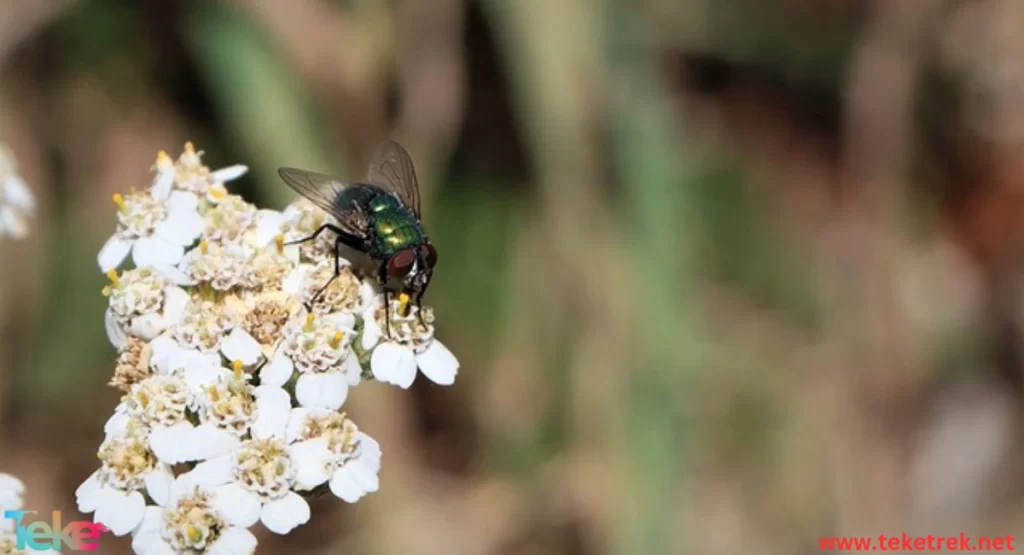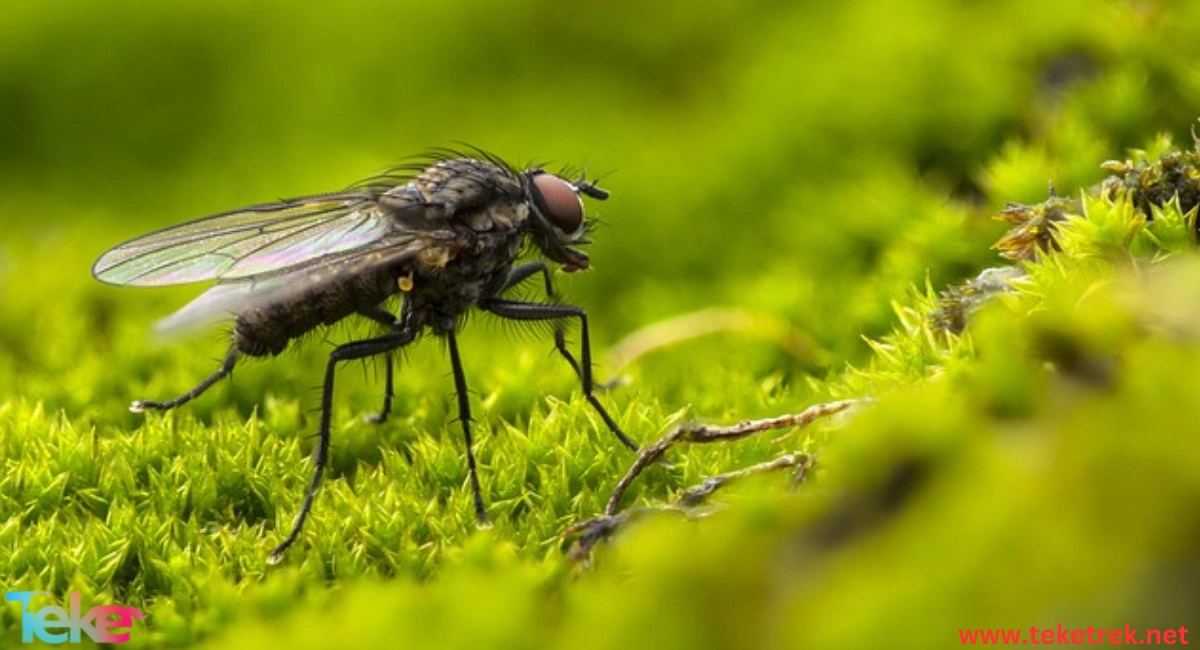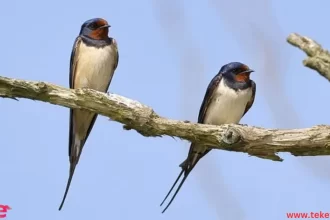Information About Flies
- Flies belong to the large group of insects with two wings, distinguished by their use of one wing during flight while using the other wing to maintain balance.
- This insect is ubiquitous, seen every day and everywhere, leading to numerous species, with approximately 150,000 species known.
- When we see flies, we’re concerned about our food and drink to prevent the spread of dangerous diseases. However, learning facts about flies might change our perspective. In this article in TekeTrek Website, we’ll focus on the most important information about this insect.
Specifications of Flies
- Body:
The fly’s body consists of several parts, each with different importance, including:
The fly’s body is composed of three main parts: the head, thorax, and abdomen.
- Eyes:
Flies usually have compound eyes composed of thousands of tiny adjacent lenses, allowing them to have a wide-angle vision. These eyes are situated on the sides of the head, covering most of it, granting flies a good vision of their surroundings. The compound eye pattern is one of the distinctive features of flies and other insects.
- Sensory Antennae
Flies have sensory antennae, which represent their strong sense of smell, relied upon for capturing prey.
- Proboscis and Feeding:
Regarding food, flies possess a proboscis for tasting and consuming food. At the top of the proboscis, there are sensors used for tasting and absorbing food.
- Legs and Wings:
Flies have three pairs of legs, and in the middle part of the thorax, there are pairs of wings, the visible wings used for flying.
The front part of the thorax contains the pair of wings used by flies for balance, as mentioned earlier.
Fly wings are usually transparent and thin. Their transparency is due to the low density of veins and tissues, allowing light to pass through.
- Abdomen:
The abdomen of flies consists of 9 segments in females and 8 segments in males.

Fascinating Facts About Flies
- Upon closer observation, flies are often seen rubbing their legs, wings, and bodies, effectively cleaning themselves of dirt.
- Flies clean themselves of dirt using their mouths, skillfully removing any clinging debris.
- While we might perceive flies as incredibly fast, their actual speed is around 7 km per hour.
- Catching flies is challenging due to their 360-degree vision, rapid reactions, and sensitivity to their surroundings. Their quick reflexes and sudden movements help them evade danger effectively.
- Flies beat their wings around a thousand times per minute, making them relatively slow flyers.
- Flies have a very rapid digestive process because their diet consists of liquids.
- Flies exhibit a variety of colors, including blue, green, or white.
- A fly’s heart beats approximately 1000 times per minute.
- Flies have one of the shortest lifespans, living only about two weeks or less.
Where do flies found?
- Flies can be found everywhere around the world, inhabiting various environments including urban, rural, and aquatic areas. Their presence depends on the type of fly and the environmental conditions.
- In general, flies are commonly found in places where suitable food resources are available, such as organic waste and decaying matter. They thrive in diverse environments across the globe.
Types of Flies
As we mentioned earlier, there are more than 150,000 species of flies, and let’s get to know the most important ones:
1. Housefly (Musca domestica): Considered a common species found in homes and farms, it measures 5-6 mm in length. It feeds on a variety of organic materials including feces and spoiled food.
2. Fruit fly (Drosophila melanogaster): It is one of the small fly species and is considered an important subject in scientific research due to its ability to reproduce quickly and easily identify its genes.
3. Bluebottle fly (Calliphora vicina): This type of fly measures 10-15 mm in length. It feeds on decaying meat, decomposed bodies, and rotten plants. It can be a health problem in some cases.
4. Stable fly (Stomoxys calcitrans): It measures 5-25 mm in length, and its males feed on nectar and plant secretions. It is found in many parts of the world and tends to move between domestic animals such as cows and horses. It can be a carrier of infection if it bites humans.
5. Stalk-eyed fly (Diopsidae):This category includes species of flies characterized by long, slender legs used to sense food and the surrounding environment. They measure 7-10 mm in length and feed on fungi and bacteria. Males compete by the size of their eyes to attract females.
6. Robber fly (Asiloidea):This category includes species of flies that rely on stealing food from other insects or available food resources. They measure 20-25 mm in length and are characterized by huge eyes, slender bodies, and spiny legs like pliers.
Fly Reproduction
- Certainly, fly reproduction is a unique biological process because flies undergo complete metamorphosis in each transitional stage.
- It starts with the egg stage, then transforms into larvae, and then into pupae until it reaches adulthood.
- Flies lay their eggs in various sites, sizes, and shapes depending on the type of insect, and within 24 hours, the egg transforms into larvae resembling white worms. These larvae prefer decaying environments. After 5 days, if they obtain sufficient and suitable food, they develop into the pupal stage and then become fully grown adult insects.
- A fly lays about 150 eggs, and hatching occurs after 3 or 4 days following mating.


Frequently Asked Questions About Flies
- What is the role of flies in life?
Flies are also a good source of food for frogs, lizards, spiders, and birds, so they are an important part of the feeding cycle within the food web and ecosystem. Some flies also have medical uses.
- What is the average lifespan of flies?
Adult flies typically live for a period ranging from 2 to 4 weeks, but they can also enter hibernation during the winter season.
- Do flies sleep or not?
Flies sleep for 16 hours a day, divided between naps during the day and rest throughout the night.
- What do flies do in a day?
He spends his day humming with his friends and is tired at bedtime. The sleepy fly looks for a safe place to rest as sunset approaches.
- Can flies see us?
In general, flies are able to see objects that are several feet away, although their vision is much sharper at closer distances. For example, some species of flies are able to detect movements that are as small as 1 degree of arc, which means they can see objects that are only a few inches away.
Finally, we can say that despite the significant harm flies cause and the many diseases they transmit, they contribute to maintaining ecological balance as an important part of the feeding cycle within the food web.







Thank you for your sharing. I am worried that I lack creative ideas. It is your article that makes me full of hope. Thank you. But, I have a question, can you help me?
yes
Thank you for your sharing. I am worried that I lack creative ideas. It is your article that makes me full of hope. Thank you. But, I have a question, can you help me? https://www.binance.com/en/register?ref=JHQQKNKN
yes
Thanks for sharing. I read many of your blog posts, cool, your blog is very good. https://accounts.binance.com/en-ZA/register?ref=JHQQKNKN